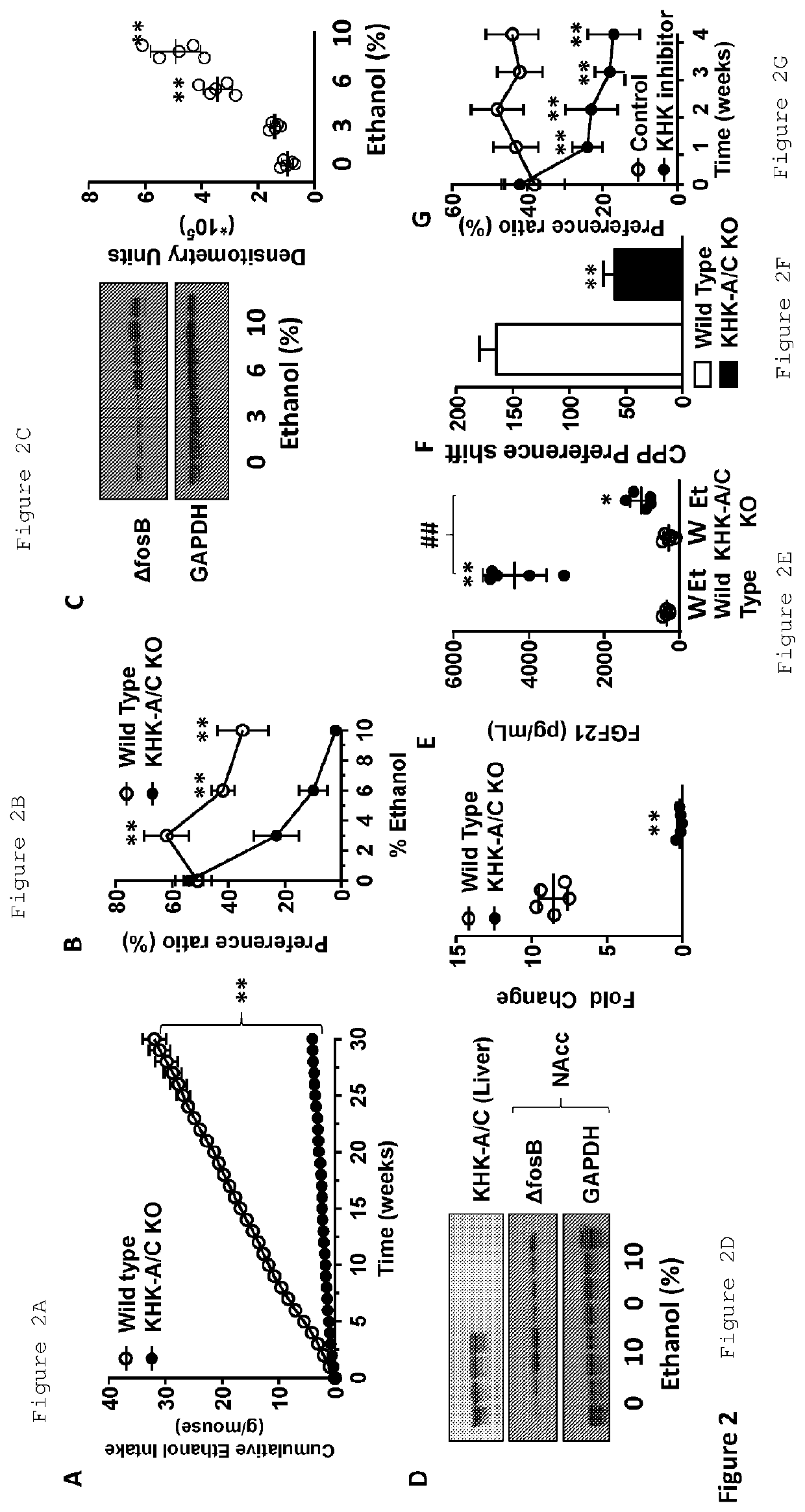Methods for fructokinase mediation of alcohol craving and alcohol induced liver disease
a fructokinase and liver disease technology, applied in the direction of heterocyclic compound active ingredients, drug compositions, plant/algae/fungi/lichens ingredients, etc., can solve the problems of craving, liver injury, liver damage, etc., to stimulate dopamine and induce toxicity
- Summary
- Abstract
- Description
- Claims
- Application Information
AI Technical Summary
Benefits of technology
Problems solved by technology
Method used
Image
Examples
example 1
ncreases Hepatic Fructose Levels
[0081]As shown in FIG. 1A, mice were administered increasing amounts of alcohol in their drinking water, beginning with no alcohol (0%), then 3%, 6% and eventually 10% alcohol. Liver tissue was removed and found small levels of aldose reductase (AR) in the liver under normal (0% alcohol) conditions, but as alcohol intake increased, there was an upregulation of AR in the kidney relative to actin control (shown in both the Western blot and densitometry). AR is likely upregulated because alcohol can raise osmolality, which is known to increase AR expression (10), and it has been discovered herein that osmolality of ethanol containing solutions is increased with increasing ethanol intake (FIG. 1B). In turn, AR is known to raise sorbitol levels and can cause oxidative stress and inflammation resulting in liver injury (11). It has been discovered herein that the livers of ethanol treated mice have increased sorbitol levels (FIG. 1C).
[0082]Sorbitol can be co...
example 2
Drives Alcohol Craving
[0083]To understand the role of fructose in alcohol intake, alcohol was provided to either wild type control mice or mice that could not metabolize fructose (fructokinase knockout mice, KHK-A / C KO). The relative liking of alcohol was first evaluated by evaluating cumulative intake of alcohol in mice provided the choice of 10% ethanol or water for 30 weeks. As shown in FIG. 2A, KHK-A / C KO mice drank much less alcohol over the 30 week period. The preference ratio was also studied (preference of alcohol / water) in wild type and KHK-A / C KO mice over a 10 week period in which they were exposed stepwise to 3%, 6% and then 10% alcohol. As shown, wild type mice drank between 35 and 60 percent of their fluids as alcohol whereas KHK-A / C KO mice showed a stepwise decreased liking of alcohol over the 10 week period. FIG. 2C shows that delta FOSB, a transcription factor associated with addiction, was induced in the nucleus accumbens of wild type mice with increasing amounts ...
example 3
and Alcohol-Induced Liver Disease
[0085]The finding that alcohol can induce hepatic fructose levels raised the question that some of the liver disease from alcohol might actually be mediated by fructose-dependent fatty liver. To determine if blocking fructose metabolism could prevent alcohol induced fatty liver, wild type mice on 10% alcohol were compared with KHK-A / C KO mice on 20% alcohol for 30 weeks. KHK A / C KO mice drink half the amount of alcohol as wild type mice. Comparison allowed for the evaluation of the effects of equivalent alcohol intake between groups. As shown in FIG. 3A, wild type mice developed fatty liver demonstrated by the vacuoles containing fat whereas KHK A / C KO mice appeared protected from fatty liver. Furthermore, KHK A / C KO mice showed less hepatomegaly (liver weight) (FIG. 3B), hepatic triglyceride accumulation (FIG. 3C), transaminitis (FIGS. 3D and 3E), as well as activation of NFκB (as noted by p65 nuclear staining) (FIG. 3F), expression of inflammatory ...
PUM
| Property | Measurement | Unit |
|---|---|---|
| Fraction | aaaaa | aaaaa |
Abstract
Description
Claims
Application Information
 Login to View More
Login to View More - R&D
- Intellectual Property
- Life Sciences
- Materials
- Tech Scout
- Unparalleled Data Quality
- Higher Quality Content
- 60% Fewer Hallucinations
Browse by: Latest US Patents, China's latest patents, Technical Efficacy Thesaurus, Application Domain, Technology Topic, Popular Technical Reports.
© 2025 PatSnap. All rights reserved.Legal|Privacy policy|Modern Slavery Act Transparency Statement|Sitemap|About US| Contact US: help@patsnap.com



